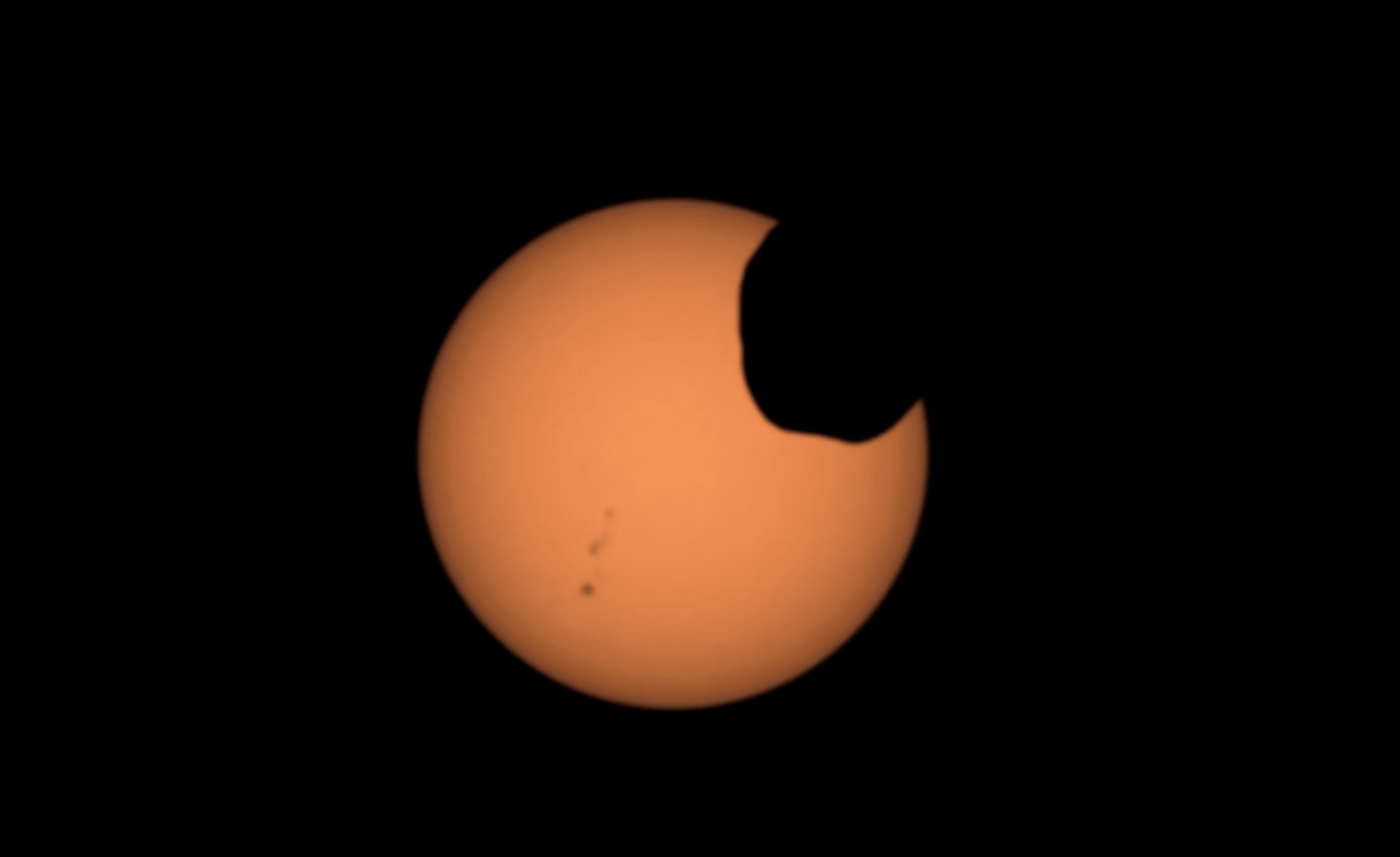Mars’ death-spiraling moon captured in gorgeous eclipse video
The moon is destined to crash into Mars’ surface.

NASA’s Perseverance rover has captured the clearest ever footage of a solar eclipse over Mars, and the results are out of this world.
The rover snapped the ethereal video of Mars’ potato-shaped moon, Phobos, moving across the face of the sun on April 2. During the eclipse, Phobos projected its uneven shadow over the Martian surface — appearing almost as though it was the pupil of a gigantic eyeball rolling in its socket.
Perseverance recorded the footage midway through its journey to a river delta on Mars’ 28-mile-wide (45 kilometers) Jezero Crater, where it will search for evidence of life on the Red Planet. Training its state-of-the-art Mastcam-Z camera on the sky, the rover recorded the misshapen moon’s solar transit with the greatest zoom and at the highest framerate ever.
Related: Giant reservoir of 'hidden water' discovered on Mars
"I knew it was going to be good, but I didn't expect it to be this amazing," Rachel Howson, a mission operations specialist at Malin Space Science Systems and one of the Mastcam-Z team members who operates the camera, said in a statement.
Phobos, named after the Greek god of fear, is roughly 157 times smaller than Earth's moon and is one of Mars' two natural satellites, alongside the even smaller Deimos (whose name comes from the Greek god of dread).
Scientists believe that the brother moons were once roaming asteroids that were snared into Mars’ orbit by the planet’s gravitational field. The orbits of these captive asteroids are unstable, according to researchers, and scientists predict that in a few tens of millions of years' time Deimos will spin out into space while Phobos will slam into Mars’ surface.
Sign up for the Live Science daily newsletter now
Get the world’s most fascinating discoveries delivered straight to your inbox.
Researchers have been making eclipse observations of Phobos from the Martian surface since 2004, when the twin NASA rovers Spirit and Opportunity snapped the first time-lapse photos of the moon’s transit. Similar observations were made by NASA's other active Mars rover, Curiosity, in 2019. These earlier images were not very detailed and were recorded in black and white, but Perserverance’s improved Mastcam-Z enabled scientists to take the first color images of the eclipse. Mastcam-Z is also equipped with a solar filter, which reduces the intensity of incoming light and enables scientists to capture never-before-seen details.
"You can see details in the shape of Phobos’ shadow, like ridges and bumps on the moon’s landscape," Mark Lemmon, a planetary astronomer with the Space Science Institute in Boulder, Colorado, said in the statement. "You can also see sunspots. And it’s cool that you can see this eclipse exactly as the rover saw it from Mars." Sunspots have been swarming the sun’s surface recently following an increase in solar activity, which have launched plasma waves at Earth’s magnetic field.
NASA isn’t just eclipse-watching for the pretty images. Making observations of Phobos’ path around Mars is vital for improving scientific understanding of the doomed moon’s death spiral. Studying eclipse footage helps scientists observe the gravitational forces between Mars and Phobos, and can provide information on the planet's interior and the tidal forces shaping its crust and mantle. The same forces also act on Phobos to subtly affect its orbit.
Perseverance is a key part of NASA's $2.7 billion Mars 2020 mission, which, alongside the Curiosity rover, is searching for signs of ancient life on Mars’ surface by collecting dozens of rock samples for eventual return to Earth over the next decade. The rover is accompanied by the Ingenuity helicopter, which has so far made 25 flights over Mars.
Originally published on Live Science.

Ben Turner is a U.K. based staff writer at Live Science. He covers physics and astronomy, among other topics like tech and climate change. He graduated from University College London with a degree in particle physics before training as a journalist. When he's not writing, Ben enjoys reading literature, playing the guitar and embarrassing himself with chess.









